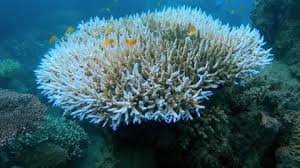Global Mass Coral Bleaching:

The US National Oceanic and Atmospheric Administration (NOAA) said the fourth global mass coral bleaching event has been triggered by extraordinary ocean temperatures.
- Corals are essentially animals, which are sessile, meaning they permanently attach themselves to the ocean floor.
- They share a symbiotic relationship with single-celled algae called zooxanthellae.
- The algae provides the coral with food and nutrients, which they make through photosynthesis, using the sun’s light.
- They use their tiny tentacle-like hands to catch food from the water and sweep into their mouth.
- Each individual coral animal is known as a polyp and it lives in groups of hundreds to thousands of genetically identical polyps that form a ‘colony’.
- Corals are largely classified as either hard coral or soft coral.
- It is the hard corals that are the architects of coral reefs — complex three-dimensional structures built up over thousands of years.
- Hard corals have stony skeletons made out of limestone that are produced by coral polyps.
- When polyps die, their skeletons are left behind and used as foundations for new polyps.
- Coral reefs, also referred to as “rainforests of the sea”, have existed on the Earth for nearly 450 million years.
- Coral reefs have a crucial role in marine ecosystems.
- Thousands of marine species can be found living on one reef.
- Coral Bleaching happens when corals experience stress in their environment due to changes in temperature, pollution or high levels of ocean acidity.
- Under stressed conditions, the zooxanthellae or food-producing algae living inside coral polyps start producing reactive oxygen species, which are not beneficial to the corals.




